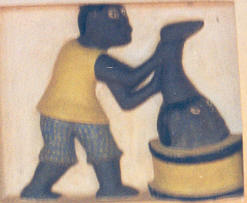|
|
The sign of FA (oracle of the Nago-Yoruba geomancy) during a divination session in Pobe (Benin)
THE ORIGINS OF ANTHROPOLOGICAL PSYCHIATRY
|
Contents of this chapter: 1) Cultural anthropology 2) Psychoanalysis, Ethnopsychoanalysis, Ethnopsychiatry 3) Phenomenology 4) Structuralism 5) Systemics 6) Sociology of social representations |
(which is also called in France ethnology - why not? but this term does not emphasize the fact, that every ethnical group, including the European or Occidental ones, ought to become equally a subject of scientific research, and that eventually the aim is to reframe their differences in a universal anthropological context).
As opposed to physical anthropology, which studies the human being as a natural thing (compared morphology), cultural anthropology studies it as a culturally and socially constructed person. It thus describes and compares some stages of society.
In some cases (for instance American culturalism of the nineteen thirties), it can also attend to the influence of social structure over individual personality. That kind of culturalism was greatly criticized, because it aimed to link, directly, social structure with a so called "basic personality". It was too easy to establish that basic personality was no more than a construction of mind, imbued with Occidental stereotypes. The link, as far as it exists, has to be manifold and dialectical: one given social feature may have many distinct psychological issues, which depend on historical, social, biographical, and constitutional peculiarities.
In this frame, what are the main tenets of cultural anthropology that we should be concerned with?
- We admit that any society cannot be reduced to sociological comments about its functioning, nor to the succeeding events of its history. Society keeps in memory, in a mainly implicit way, a background of experience which enables us to give value and meaning to these events, and their actors. That background is called culture.
- We admit that any social actor - any human being - is consequently implied in a net of assessing and meaning processes, which on a large extent determine his social position, his identity, and his behaviour.
The notion of culture has been sometimes considered irrelevant in the field of human sciences. On the one hand it is ambiguous: there exists as many definitions of the word as there are users. Moreover, there is not one culture only for every population, but several cultural fields which overlap, and several cultural levels which coexist, including in a single individual. That is all true. However, it is impossible to do without that notion. So the best way is to try and provide the term "culture" with a strict and consensual definition, and to accept its complexity. This has at least one advantage: it prevents any attempt to transform culture into an object. For it would be as absurd - and dangerous - to identify a culture with a group, as to identify a people with a race.
Medical anthropology is a branch of cultural anthropology which is interested in medical concepts and healing practices throughout the world. It contributes to the idea that nosographic systems are culturally built, that illnesses - including those most strongly bound with biological causes - are also collective representations, and that, in one way, the efficacy of healing practices rests on the fact, whether they are, or not, congruent with these representations.
2) Psychoanalysis, ethnopsychoanalysis, ethnopsychiatry
Psychoanalysis was born from the clinical observation of facts and people related to time and space. To what extent can its conclusions - as far as we accept them - be generalized? The debate began very early. It focused on the question of the Oedipus complex universality. The given answer is very instructive: under the very form described by FREUD, the Oedipus complex can assume individual variants, which among others depend on family organization models. Family setting varies enormously according to different societies, but a common base remains. Thus, all the variants of the complex have a common structure, which seems to be the minimal conditions required to develop simultaneously, a non-psychotic state of being, an articulate language, and a social life. Therefore that structure is universal, for the whole of mankind. This crucial example gives a hint of what could be a general solution to the problem of the universality of psychoanalysis. It lies in the hierarchical grading of problems, starting from the universal level towards the individual one, passing through the culture and the family levels. By going from the most general level to the most particular, what is is lost in scope is gained in accuracy.
Psychoanalytical concepts are relevant to anthropological psychiatry, but they are not specific to it. On the other hand, some peripheral concepts in the field of psychoanalytical theory can become crucial in this new context. Most relevant are the notions of personal identity and identification, those of the imaginary and the symbolic, those of fantasm and representation.
George DEVEREUX, who founded Complementarist Ethnopsychoanalysis, was a true orthodox Freudian. The thought of LACAN made him angry. As a personal contribution, he dared tackle frontally the problems rising from freudian psychoanalysis applied to people outside Occidental culture. For that purpose he created specific concepts which are parallel to psychoanalytical ones, and consistent with them. For instance, his idea that Schizophrenia is an ethnical disease linked with occidental culture, though provoking, seems to be very meaningful. It does not compete with epidemiological studies, which state an equal prevalence rate all over the world: what varies is the evolution of the disease, hence the destiny of the schizophrenic patients. On the other hand, its statement is that, psychosis being a universal phenomenon, Schizophrenia, defined as a chronic dissociative mind process, is a varying form of psychosis, favoured by the occidental way of life where prevail individual loneliness and the cultural lack of symbolic reinsertion proceedings of the insane.
Tobie NATHAN's ethnopsychiatry (a word that already other authors used) was born altogether from DEVEREUX's teaching and from the need to elaborate a therapeutic answer to the scandal of migrant people sinistrosis: that a trite work injury should lead to a chronic disabling syndrome, without any "objective basis" but caused, or increased, by some "paranoid claiming" against the physicians or the medical control authorities disqualified altogether medicine and psychiatry. NATHAN had the merit of inventing an original and efficient psychotherapic technique (the so-called "consultation d'ethnopsychiatrie ") which in its setting makes reference to the communal social practices in traditional societies and helps the patients to cope with the two different cultural contexts: the one where they come from and the one where they now live. The dispute about the evolution of his practice relates less to the neglect of some formerly admitted psychoanalytical statements (why not, after all?), or to the adoption of some rational practices directly inspired by those of traditional healers, than to a theoretical tendency to make culture an absolute, and to underrate the universal dimension of human experience.
In another field, the rightly discredited colonial psychiatry nevertheless bore some good fruit: those which resolutely took the opposite course of the main European centered stream, which in a first stage discovered and described the picturesque and the efficacy of traditional therapies, in a second stage, their rational basis, the logical closeness of their therapeutic process, and finally their universal significance. At the Fann Hospital (near Dakar), following Henri COLLOMB, a whole school experienced that "ambiguous adventure" between medicine, ethnography and psychoanalysis, and concretely discovered the influence of the respective social position of physicians and traditional healers on their collaboration.
3)Phenomenology:
Why will we include phenomenology - a philosophic method - amongst the origins of anthropological psychiatry? Because that method (which describes each phenomenon perceived by the human being, without referring to any acquired or inherited knowledge, being suspicious even of the common speech as implicitly carrying a lot of received opinions) can also be applied to psychopathology, and can describe the world experience of psychotic or neurotic people, while putting aside any previous science. This way of thinking was called "phenomenological reduction". It differs completely - being even the opposite - from the present-day atheoretical postures. These latter, indeed (for instance - horresco referens - "evidence based medicine"), while rejecting theories, neglect to criticize their own bases, and therefore do not escape being determinated, unawares, by unmastered theoretical or ideological postures. On the contrary, the phenomenological approach considers all theories as "phenomena", without allowing them to play their role as theories, which consists in debriefing reality and guiding the speech act. It rejects any a priori meaning, while aiming to point out how it does come to things ("comment le sens vient aux choses"). Hence, phenomenological psychiatry asserts its independance from the various cultures (which are nothing but general theories of the world), nevertheless considering with a deep interest every cultural manifestation as a meaning giving process.
Phenomenological psychiatry may indeed be criticized for not having produced any well-defined and efficacious therapeutical method. This points out the role of theories: by nature inaccurate, but irreplaceable as means of action over reality. In order to be useful, phenomenological psychiatry has to conclude a tactical alliance with a theory, considered as a lesser wrong. It will make use of it for action, while criticizing it ceaselessly in order to avoid driftings, which otherwise would be inevitable. Not long ago, phenomenology had concluded with psychoanalysis an alliance of that kind. The works of A. DE WAELHENS, P. DEMOULIN... give a fine evidence of it.
Anthropological psychiatry could all the more enter in to this alliance, that it does not pretend to say the truth, but only to be a fruitful approach of complex phenomena.
4) Structuralism:
Nothing seems to be further from phenomenology than structuralism. In the nineteen sixties, their respective supporters fought it out. An article of J. LADRIERE, "Sens et système" (Meaning and System), perfectly summed up the dispute: by showing how the meaning of things is born, phenomenology takes up a genetic, temporal, "diachronic" perspective. Moreover, it only applies to phenomena (what is apparent). Abstract generalities are irrelevant. On the contrary, structuralism states that a systemic interaction between all the observable elements of a given present-day reality does exist. Moreover, it states that the whole organization only reveals itself to the distant observer, when he focuses on the hidden (and abstract) structures of phenomena. So structuralism is more interested in "synchronic" relationships between phenomena than in their historical genesis. However, this difference only concerns methodology, and only points out to the necessary complementarity of both approaches.
We have still to underline the close relationship which exists between structuralism and linguistics, on one hand, and cultural anthropology on the other hand. F. de SAUSSURE's structural linguistics is the intellectual matrix: SAUSSURE showed that any human language is a system of interacting elements, and that the change of any given element, sooner or later, will modify all the other ones. He stated that between two languages of the same origin, the phonems of words of the same etymology vary following a quite rigorous equivalence grid. When we compare them we find them identical, in spite of their morphological difference. He established the well-known distinction between Signifying (the word as sounds), Signified (the concept that the word designates) and the Referent (what corresponds to the word in the real world). This distinction is a basis for understanding any symbolic relationship, even beyond the language field. He showed that contrary to a deeply rooted belief of common sense, there is generally no necessary connection between Signifying and Signified : the Sign has to be considered as arbitrary.
Cl. LEVI-STRAUSS applied the principles of SAUSSURE's structural linguistics to cultural anthropology. He studied Amerindian myths as transforming systems, and showed that the basic identity of two related myths could only be discerned when using an equivalence grid taking into account the social setting of each society, particularly the kinship system. Consequently, one setting structure can govern altogether marriage and inheritance rules, and also cosmogonic narratives (this being just one example). For cultural anthropology too, the Sign is arbitrary: contrary to common sense, indeed, differences of social setting are not dependent on utilitarian or functional reasons, but on structural necessities which only refer to themselves.
5) Systemics:
Structuralism makes reference to systemics, but systemics as a theory is broader than structuralism. It proceeds from the General Theory of Systems, we owe to L. von BERTALANFFY, who elaborated his work circa 1925. At first, it was just a theory of biological systems, gradually extended to ecological, sociological, and cultural ones, and finally to formal systems. The starting point is the noting that a living organism is a complex unity, made from interactive elements which sometimes appear to be very far from one another, in the space as well as in the system setting itself. Noticing that several organisms of the same species, living in a given area, could often behave in some respects as one single organism, was an important spring of theoretical generalization. Ecology soon established that all the living species in a given area had dealings with one another, that natural physical and chemical phenomena took part in such interactions, that eventually the limits of the area where the interaction was noted were prodigiously extensive (it is what people suggestively call 'the butterfly effect"). Another stage of generalization was to consider social and cultural data as interactive systems, insofar as their development does not only depend on identified social actors, but also on what we may call "spirit of the time", a purely speculative notion until we discern in it the action of millions of anonymous actors, with all their determinisms.
The main difference between structuralism (as it was formalized) and systemics, is that the latter was soon given a practice: that is a method for acting on reality, specially in the field of therapy, but also in the field of social work, politics, and strategy in general. Since the effect of a voluntary, goal oriented action, is often the opposite to the expected result, because of inner resistances, the ratio of forces and the retroactive consequences have to be taken into account in a systematic way. Otherwise we cannot have any efficacious strategy. Of course some ethical problems may rise, which we have to face and to solve. But once we have become conscious of the systemic effects of our acts, the solution will never be to ignore them anymore.
The most well-known schools of systemic therapy adopted the methodological principle of hic et nunc, that is to say, working with what arises in the time and space of intervention. The rest can be neglected. Doing so, they are in contrast with psychoanalysis which made an opposite choice. This petitio principii may be upheld, in so far as we have to solve a problem. It has no sense when we pretend to understand a matter under all its aspects. Practically, the systemic therapists often neglect one dimension of the problems they treat, the importance of which is staring in the face: I mean the economic and social factors, which are bound with the immersion of the human being in society, which is ruled on one hand by the ratio of forces, and on the other hand by social representations.
6) Sociology of social representations:
From its beginning, psychoanalysis has maked use of the concept of representation (Vorstellung), meaning the individual activity of production of consciousness contents, or the product of this activity. But during the period of FREUD's life time, DURKHEIM discovered that some representations were, in fact, collective creations. He gave the totem as an example. The collective representations are present in the mind of individuals, as individual representations, without being the property of anyone. They are inherited from the social milieu where they were formed, and they are needed in that social milieu by the logical constraints of human interaction.
In 1961, S. MOSCOVICI gave to this notion, which had become a little forgotten, a new life as a "methodological instrument for social psychology of knowledge" (M.-N. SCHURMANS, 1990). The question is to understand how individual minds, with so varied life experiences, manage to share so many common ideas, even in the very fields which hardly ever deal with any explicit collective thinking.
Individual representations seem to rise from the interaction between a mind capable of reflection, and its environment which sends him back the results of his acts. In the same way, collective representations arise from the interaction between social actors, following the results of their interaction, and following the way they make and exchange comments about it. Once they are constituted, social representations stand outside the consciousness of individuals. "They have the power of calling one another, of repelling one another, of making among themselves all kind of synthesis..." (E. DURKHEIM, 1898). They are "socially elaborated rebuildings of a consensual reality" (M.-N. SCHURMANS, ibid.). Owing to this notion, culture can certainly get some concrete and dynamic meaning. Concretely, culture is made of the whole of social representations, connected to one another by logical ties, and of the whole of the bonds which unite these representations with the concrete situations they have risen from, to which they refer to in the real world. The dynamic of a culture is due to the fact that representations are born of social interaction and constantly interfere with it.
 |
 |
 |
Ornaments from the King Ghezo palace, Abomey (Benin Republic)